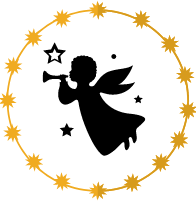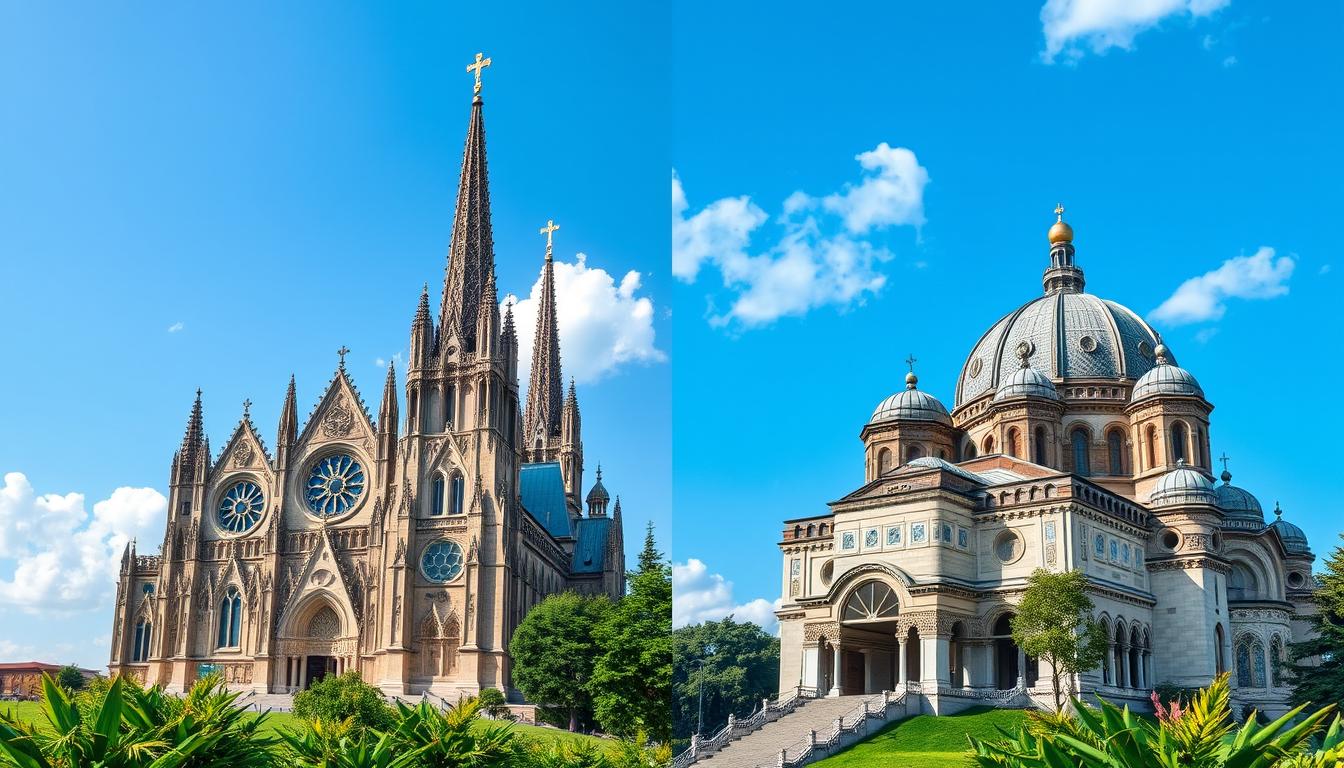Christianity is a rich and diverse religion. It has many beliefs, practices, and cultural expressions. When I look at different Christians, I’m amazed by how this faith fits into various contexts.
Welcome to checkreligion.com
Different Christians !
From traditional rituals like baptism to modern worship, Christian diversity is alive. It’s a colorful tapestry woven through history.
Exploring different groups, I see how Christians take in or leave out cultural influences. This leads to unique views of scripture and practices. Debates on ethics, like alcohol and polygamy, show Christianity’s multicultural nature.
Each tradition has its own view, starting a conversation about living Christian beliefs today. This makes Christianity’s dialogue rich and ongoing.
I want to talk about the different branches and denominations in Christianity. They add to the faith’s rich dialogue. Each group’s understanding shapes their views on gender and sexuality, making their beliefs complex.
Through this, I hope to show how Christians express their faith in many ways. I also want to highlight how they deal with life’s complexities.
Key Takeaways
- Christianity is characterized by its cross-cultural diversity with no single dominant expression.
- Christian beliefs and practices vary significantly across different cultural contexts.
- Debates on topics like divorce, sexuality, and alcohol reflect the multicultural essence of the faith.
- Common rituals among Christians, such as baptism and communion, showcase shared elements.
- Understanding the diversity in Christianity requires examining its historical development and regional differences.

Understanding Christian Denominations
Christian denominations are a key part of the Christian world. They show the wide range of beliefs among Christians. Each one has its own set of beliefs, practices, and how it’s organized.
What is a Christian Denomination?
A Christian denomination is a group within Christianity with its own views. They are different from sects, which often split over big disagreements. Major groups like Roman Catholicism, Eastern Orthodoxy, and Protestantism are the base for many others.
Each denomination has its own take on theology, how it’s run, and how it worships. Yet, they all share the main ideas of Christianity.
Major Categories of Denominations
Christian denominations fall into three main groups. Each has its own identity and ways of practicing:
| Denomination | Origin | Key Beliefs | Unique Practices |
|---|---|---|---|
| Roman Catholicism | Traces back to the Apostles, officially organized in the early centuries | Emphasizes the authority of the Pope, sacraments, and tradition | Observes holy days like Christmas and Easter, acknowledges the Catholic Bible |
| Eastern Orthodoxy | Separated from Western churches in 1054 | Focus on Holy Tradition and the sacraments | Rich liturgical life, observes Divine Liturgy, emphasis on icons |
| Protestantism | Originated in the 16th century with leaders like Martin Luther | Emphasizes scripture alone, personal faith, and the priesthood of all believers | Varied practices with subgroups like Baptist, Lutheran, and Anglican |
Different Christians find their faith in many denominations. This makes the Christian world lively and always changing. Each group adds to them.

The Branches of Christianity
Christianity is a big faith with two main parts: western and eastern. Each part has its own beliefs and traditions. This shows how diverse Christian worship and practice can be.
We will look closely at western christianity, which includes catholicism and protestantism. We will also explore eastern christianity, mainly the orthodox churches.
Western Christianity: Catholicism and Protestantism
Western christianity is mostly about catholicism and protestantism. The Catholic Church has over 1.3 billion followers. Protestants have grown to over 600 million in 2024.
Protestantism has many groups like Anglicanism and Lutheranism. These groups started because of big changes in Christianity, like the Protestant Reformation in 1517. People like Martin Luther were key in these changes.
Eastern Christianity: Orthodox Churches
Eastern christianity is mostly the orthodox churches. They have about 230 million followers. This group is big in Eastern Europe, the Middle East, and North Africa.
Eastern and western christianity differ in their views and scripture. Western christianity looks at church authority and doctrine. Eastern christianity values tradition and the mystical side of faith. Knowing about these branches shows the beauty of Christianity.

The Catholic Church and Its Practices
The Catholic Church is a big part of Christianity. It has many traditions that help its followers grow spiritually. The sacraments are key, bringing people closer to God.
The Sacraments of the Catholic Faith
The Catholic Church has seven sacraments. Each one is important for a believer’s journey. Here are the sacraments:
- Baptism: Starts a person’s journey in Christianity and washes away original sin.
- Confirmation: Makes Baptism stronger, helping people become active in the Church.
- Eucharist: Remembers the Last Supper and the belief in changing bread and wine into Jesus.
- Penance: Forgives sins through confession and doing penance.
- Anointing of the Sick: Helps those who are very sick or old.
- Matrimony: Celebrates the marriage bond.
- Holy Orders: Makes men into priests, bishops, and deacons.
Each sacrament shows important parts of Catholic beliefs. They help people get closer to God. They are important channels of God‘s help.
The Role of the Pope in Catholicism
The Pope is the spiritual leader of the Catholic Church. He is seen as the successor to Saint Peter. His role is not just for show; he is the final say in faith and morals.
The Pope’s influence comes from a long line of bishops. This line goes back to Christ. His teachings guide Catholics everywhere.
In short, the Catholic Church’s traditions and the Pope’s leadership show its strong faith. These things help make the Church a vibrant place of faith. Over 1.33 billion Catholics worldwide share this faith.
Protestantism: A Branch of Christianity
Protestantism is a big part of Christianity. It started in the 16th century. It wants to go back to the Bible’s teachings.
Many important people worked hard to change the Catholic Church. They wanted things to be more like the Bible says.
Key Figures and Historical Background
Big leaders helped start and grow Protestantism. Martin Luther is a key figure. He lived in Germany and wrote the 95 Theses.
John Calvin and Huldrych Zwingli also played big roles. They believed in faith alone and read the Bible differently than the Catholic Church.
Denominational Diversity within Protestantism
Protestantism has many groups because it appeals to many people. Some big groups are:
- Lutherans – They follow Martin Luther and believe in faith alone.
- Anglicans – They started in the Church of England and try to find a middle way.
- Methodists – John Wesley started them. They focus on faith and helping others.
- Baptists – They believe in believer’s baptism and local church rule.
These groups have different ways of worship and beliefs. They meet often, celebrate holidays, and have special rituals.
| Denomination | Founder(s) | Key Beliefs | Sources of Authority |
|---|---|---|---|
| Lutheranism | Martin Luther | Justification by faith alone | The Holy Bible |
| Anglicanism | Henry VIII | Balance between ritual and scripture | The Book of Common Prayer, The Bible |
| Methodism | John Wesley | Personal faith and social action | The Bible, tradition |
| Baptists | John Smyth | Believer’s baptism and autonomy of local congregations | The Bible |
In short, Protestantism focuses on faith, the Bible, and important people. This has led to many different beliefs and practices today.
Eastern Orthodox Churches
The Eastern Orthodox Churches have a rich history in Christianity. They have unique beliefs and practices. These traditions include liturgical worship, the communion of saints, and the Eucharist’s power.
Distinct Beliefs and Practices of Eastern Orthodoxy
Eastern Orthodox Christianity has its own set of beliefs. They don’t follow the pope but believe in Christ’s authority. They make decisions together, with all bishops.
They value the saints’ prayers a lot. They also believe Christ is really in the Eucharist. This makes their worship special.
Mary is very important to them. They believe she went to heaven body and soul. These beliefs show the heart of Eastern Orthodox faith.
Liturgical Worship and Traditions
Their worship is detailed and full of meaning. The Divine Liturgy is key, blending community and personal devotion. It’s filled with symbols and history.
Icons are very important in their worship. They see them as a way to connect with God. Incense, chant, and the church’s smell make worship a special experience.
With 220 million followers, Eastern Orthodoxy is strong. Despite cultural differences, their tradition and worship unite them.
| Aspect | Eastern Orthodox | Other Branches |
|---|---|---|
| Authority | No pope authority; councils govern | Pope as key authority in Catholicism |
| Communion of Saints | Belief in intercession of saints | Varies by denomination |
| Eucharist | Real transformation; body and blood | Symbolic interpretation in many protests |
| Veneration of Mary | Bodily assumption belief | Varies; often honored but not in same context |
Understanding Christian Sects and Groups
Christianity has many beliefs and practices. It goes beyond the big groups we often hear about. There are many lesser-known christian sects that make Christianity rich and diverse. Learning about these sects helps us see how they are different from the big groups.
Exploring Lesser-Known Christian Sects
Some lesser-known groups are the Anabaptists, Pentecostals, and Charismatic churches. Pentecostalism is now the biggest Protestant group worldwide. It’s growing fast in places like Asia and Africa.
Anabaptist groups, like the Mennonites and Amish, live simple lives. They don’t get involved in the world. Charismatic churches believe in spiritual gifts, but they’re not the same as Pentecostals.
How Sects Differ from Major Denominations
Sects and major denominations have different views on scripture and beliefs. Big groups like Anglican, Lutheran, and Roman Catholic follow certain creeds. These creeds help shape their beliefs about God and Jesus.
The Church of Christ, for example, believes in keeping things simple. They only follow the Bible, without creeds. This is different from bigger groups that use many texts for guidance.
- Major denominations define their foundation through creeds and doctrines.
- Lesser-known sects may focus on alternative interpretations or emphases not found in mainstream teachings.
- Differences in views on authority and inspiration of scripture lead to varied practices and beliefs.
Exploring christian sects helps us understand the many beliefs in Christianity. It shows that even small groups have big differences in their beliefs.
Christian Traditions and Cultural Influences
Christian traditions are very diverse. They come from cultures all over the world. Each place where Christianity is found has its own story. This story shows the customs, languages, and histories of different Christians.
At first, early Christians followed Jewish customs. But as Christianity grew, it took on Greek and Roman traditions too. This mix created different ways of celebrating and understanding Christian beliefs.
The gospel spread far and wide. It touched many cultures, making a colorful mix of practices everywhere.
Christianity has played a big role in shaping values and institutions. The Catholic Church helped a lot in Western civilization. It helped in science, education, and helping others.
The Eastern Orthodox Church also made a big impact. It changed the cultures of Eastern and Southeastern Europe, and the Near East.
Protestantism brought its own culture. It changed politics, arts, and education. Christian traditions are part of local customs, especially on holy days and in church.
It’s amazing how faith and culture mix in Christianity. This shows how Christianity can change yet stay true to its teachings.
Different Christians: The Impact of Theology and Beliefs
Exploring theology shows how different beliefs shape daily life for Christians. In Austin, Texas, I met people from many Christian backgrounds. These talks showed the beauty of Christian diversity.
People’s faiths varied because of different views on salvation, God’s nature, and the Bible. This diversity makes faith unique for each person.
God’s nature differs between Christianity and other religions. Buddhism doesn’t believe in God, while Islam sees Allah as one. Christianity sees God as three persons in one.
Hinduism has many views, from many gods to no gods. This shows how beliefs can vary greatly.
How people reach God also varies. Buddhism has the 8-fold Path, and Islam has the 5 Pillars. Christianity focuses on Jesus’ message.
| Religion | View of God | Path to the Divine |
|---|---|---|
| Buddhism | No belief in God | 8-fold Noble Path |
| Islam | Impersonal monotheism (Allah) | 5 Pillars |
| Christianity | Personal trinitarianism | The gospel of Jesus |
| Hinduism | Varies (Polytheism to Atheism) | Undefined; varies widely |
Stephen Prothero says in “God is Not One” that these differences matter. He believes that saying all religions are the same is not true. This affects how Christians see their faith.
Talking with people showed that many value respect for all beliefs. But, it’s important to honor each faith’s unique teachings. This way, Christian diversity truly shines.
Christian Unity amidst Diversity
Christian beliefs show us a deep truth. Many beliefs bring us together, even when we’re different. The core of our faith, like Jesus’ divinity and love, unites us all.
Common Beliefs Across Different Christian Groups
For a long time, finding common ground has been key. The Bible teaches us to love and live in harmony. This helps us feel closer to each other as followers of Christ.
- Love and Compassion: Love is a powerful message across all denominations.
- The Divinity of Jesus: Jesus’ divine nature is a key belief for all Christians.
- Baptism: Baptism is a shared ritual that shows our faith commitment.
- Scriptural Teachings: Verses like Psalms 133:1 remind us of our unity.
The Importance of Ecumenism
Ecumenism helps different Christian groups talk and work together. It focuses on big issues and spreading the gospel. In places like Clear Creek Community Church, diversity is a big goal.
In cities like Houston, diversity is a chance to show unity. Paul’s teachings in Ephesians and 1 Corinthians inspire us. We aim to welcome everyone to our spiritual journey. Our goal is to share love and hope with everyone in the 4B Area.
Conclusion
Exploring different Christians shows us a rich and complex world. Each group has its own beliefs and ways of practicing faith. They all start with Jesus Christ.
For example, The Church of Jesus Christ of Latter-day Saints has the Book of Mormon. Catholic and Protestant groups have their own traditions. These differences make Christianity more interesting and meaningful.
Despite our differences, we can find unity. We share values like love, compassion, and community. Talking openly and understanding each other can bring us closer.
My journey through Christian denominations has shown me both differences and commonalities. Seeing the value in our diversity helps us see Christianity as more than just sects. It’s a living, growing faith that brings us together.
As I meet more Christians, I aim to respect and understand their beliefs. I want to create a space where we can all hope for a better world together.
FAQ
What is meant by Christian diversity?
Christian diversity means there are many kinds of Christianity. This comes from different views of scripture and traditions. It also includes cultural influences.
How do Christian denominations differ from sects?
Denominations are big groups with their own beliefs and ways of doing things. Sects are smaller groups that might see things differently. They might not follow the main teachings.
What are the major branches of Christianity?
Christianity has two big branches. Western Christianity includes Catholics and Protestants. Eastern Christianity is mainly Orthodox churches. Each branch has its own beliefs and ways of worship.
Can you explain the significance of sacraments in the Catholic Church?
Sacraments are very important in the Catholic Church. There are seven main ones. They help believers get closer to God and mark important parts of their faith journey.
Who were some influential figures in the Protestant Reformation?
Important people like Martin Luther, John Calvin, and Ulrich Zwingli helped start the Protestant Reformation. They challenged old beliefs and brought new ideas to Christianity.
What makes Eastern Orthodox Churches unique?
Eastern Orthodox Churches value tradition and use icons in worship. They believe in becoming one with God, which is different from other Christian groups.
Can you share examples of lesser-known Christian sects?
There are groups like Jehovah’s Witnesses and the Latter-Day Saints. They have their own beliefs and ways of practicing Christianity, which is different from most denominations.
How do cultural influences affect Christian traditions?
Culture shapes how Christianity is practiced around the world. Customs, languages, and local stories influence faith in different places.
How do differing theologies impact Christian practices?
Different views on God, salvation, and scripture lead to many practices and beliefs. This variety makes Christianity rich and diverse.
What are the common beliefs shared across different Christian groups?
Many Christians believe in Jesus’ divinity, the importance of love, and the significance of baptism. These shared beliefs help unite Christians despite their differences.
What is ecumenism, and why is it important?
Ecumenism is about working together and understanding among different Christian groups. It aims to bridge divides and create a united Christian community.

